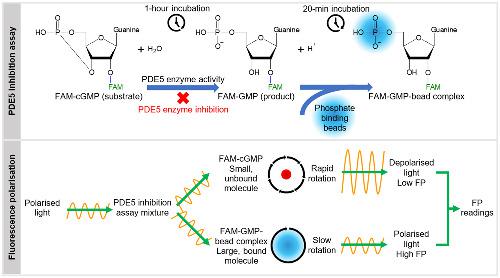当前位置:
X-MOL 学术
›
Drug Test. Anal.
›
论文详情
Our official English website, www.x-mol.net, welcomes your feedback! (Note: you will need to create a separate account there.)
Fluorescence polarisation for high-throughput screening of adulterated food products via phosphodiesterase 5 inhibition assay
Drug Testing and Analysis ( IF 2.9 ) Pub Date : 2020-09-22 , DOI: 10.1002/dta.2926 Ahmad Yusri Mohd Yusop 1, 2 , Linda Xiao 1 , Shanlin Fu 1
Drug Testing and Analysis ( IF 2.9 ) Pub Date : 2020-09-22 , DOI: 10.1002/dta.2926 Ahmad Yusri Mohd Yusop 1, 2 , Linda Xiao 1 , Shanlin Fu 1
Affiliation

|
The surge in the consumption of food products containing herbal aphrodisiacs has driven their widespread adulteration. A rapid screening strategy is, therefore, warranted to curb this problem. This study established an enzyme inhibition assay to screen phosphodiesterase 5 (PDE5) inhibitors as adulterants in selected food products. Fluorescein-labelled cyclic-3′,5′-guanosine monophosphate was utilised as substrates for the PDE5A1 enzyme, aided by the presence of nanoparticle phosphate-binding beads on their fluorescence polarisation. The sample preparation was optimised to improve the enzyme inhibition efficiency and applied to calculate the threshold values of six blank food matrices. The assay was validated using sildenafil, producing an IC50 of 4.2 nM. The applicability of the assay procedure was demonstrated by screening 55 distinct food samples. The results were subsequently verified using confirmatory liquid chromatography–high-resolution mass spectrometry (LC-HRMS) analysis. Altogether, 49 samples inhibited the PDE5 enzyme above the threshold values (75.7%–105.5%) and were registered as potentially adulterated samples. The remaining six samples were marked as nonadulterated with percentage inhibition below the threshold values (−3.3%–18.2%). The LC-HRMS analysis agreed with the assay results for all food products except for the instant coffee premix (ICP) samples. False-positive results were obtained for the ICP samples at 32% (8/25), due to possible PDE5 inhibition by caffeine. Contrarily, all other food samples were found to produce 0% (0/30) false-positive or false-negative results. The broad-based assay, established via a simple mix-incubate-read format, exhibited promising potential for high-throughput screening of PDE5 inhibitors in various food products, except those with naturally occurring phosphodiesterase inhibitors such as caffeine.
中文翻译:

通过磷酸二酯酶 5 抑制试验对掺假食品进行高通量筛选的荧光偏振
含有草药壮阳药的食品消费量的激增推动了它们的广泛掺假。因此,有必要采用快速筛选策略来解决这个问题。本研究建立了一种酶抑制试验,以筛选作为选定食品中掺假物的磷酸二酯酶 5 (PDE5) 抑制剂。荧光素标记的环状 3',5'-鸟苷单磷酸被用作 PDE5A1 酶的底物,并在其荧光偏振上存在纳米颗粒磷酸盐结合珠。优化样品制备以提高酶抑制效率,并应用于计算六种空白食品基质的阈值。该测定使用西地那非进行验证,产生 IC 504.2 纳米。通过筛选 55 个不同的食物样品证明了该测定程序的适用性。随后使用确证性液相色谱-高分辨质谱 (LC-HRMS) 分析对结果进行了验证。总共有 49 个样品抑制了高于阈值 (75.7%–105.5%) 的 PDE5 酶,并被登记为可能掺假的样品。其余六个样品被标记为未掺假,抑制百分比低于阈值 (-3.3%–18.2%)。除速溶咖啡预混物 (ICP) 样品外,LC-HRMS 分析与所有食品的分析结果一致。由于咖啡因可能抑制 PDE5,ICP 样品的假阳性结果为 32% (8/25)。相反,发现所有其他食品样品产生 0% (0/30) 的假阳性或假阴性结果。通过简单的混合-孵育-读取格式建立的基础广泛的检测显示出在各种食品中高通量筛选 PDE5 抑制剂的潜力,但天然存在的磷酸二酯酶抑制剂(如咖啡因)除外。
更新日期:2020-09-22
中文翻译:

通过磷酸二酯酶 5 抑制试验对掺假食品进行高通量筛选的荧光偏振
含有草药壮阳药的食品消费量的激增推动了它们的广泛掺假。因此,有必要采用快速筛选策略来解决这个问题。本研究建立了一种酶抑制试验,以筛选作为选定食品中掺假物的磷酸二酯酶 5 (PDE5) 抑制剂。荧光素标记的环状 3',5'-鸟苷单磷酸被用作 PDE5A1 酶的底物,并在其荧光偏振上存在纳米颗粒磷酸盐结合珠。优化样品制备以提高酶抑制效率,并应用于计算六种空白食品基质的阈值。该测定使用西地那非进行验证,产生 IC 504.2 纳米。通过筛选 55 个不同的食物样品证明了该测定程序的适用性。随后使用确证性液相色谱-高分辨质谱 (LC-HRMS) 分析对结果进行了验证。总共有 49 个样品抑制了高于阈值 (75.7%–105.5%) 的 PDE5 酶,并被登记为可能掺假的样品。其余六个样品被标记为未掺假,抑制百分比低于阈值 (-3.3%–18.2%)。除速溶咖啡预混物 (ICP) 样品外,LC-HRMS 分析与所有食品的分析结果一致。由于咖啡因可能抑制 PDE5,ICP 样品的假阳性结果为 32% (8/25)。相反,发现所有其他食品样品产生 0% (0/30) 的假阳性或假阴性结果。通过简单的混合-孵育-读取格式建立的基础广泛的检测显示出在各种食品中高通量筛选 PDE5 抑制剂的潜力,但天然存在的磷酸二酯酶抑制剂(如咖啡因)除外。



























 京公网安备 11010802027423号
京公网安备 11010802027423号